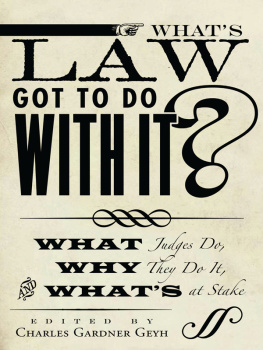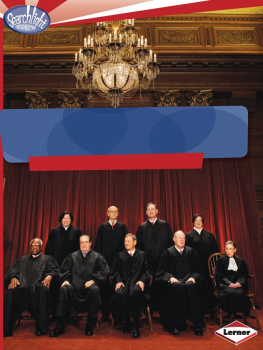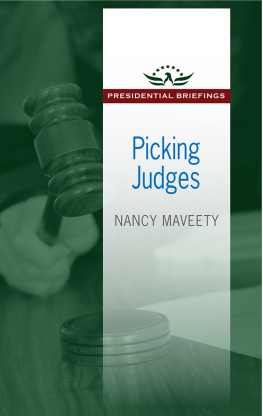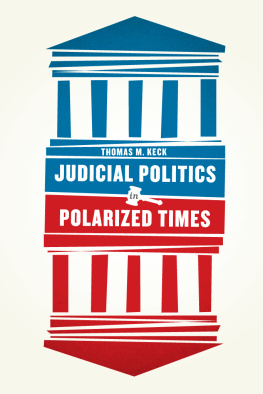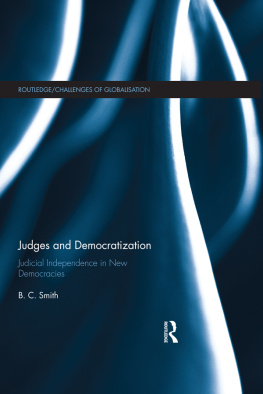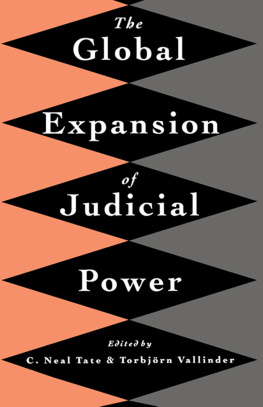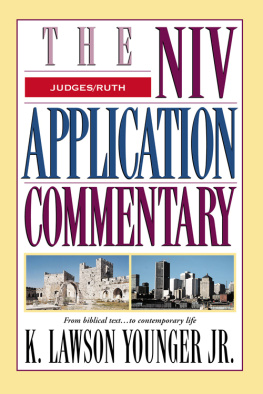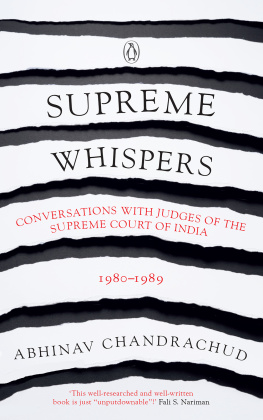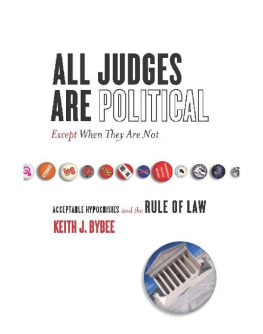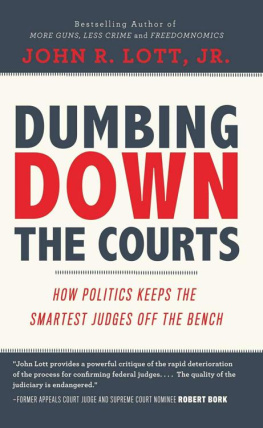Stanford University Press
Stanford, California
2011 by the Board of Trustees of the Leland Stanford Junior University.
All rights reserved.
No part of this book may be reproduced or transmitted in any form or by any means, electronic or mechanical, including photocopying and recording, or in any information storage or retrieval system without the prior written permission of Stanford University Press.
Printed in the United States of America on acid-free, archival-quality paper
Library of Congress Cataloging-in-Publication Data
Whats law got to do with it? : what judges do, why they do it, and whats at stake / Edited by Charles Gardner Geyh.
pages cm.
Includes bibliographical references and index.
ISBN 978-0-8047-7532-8 (cloth : alk. paper)
ISBN 978-0-8047-7533-5 (pbk. : alk. paper)
1. Judicial processUnited States. 2. JudgesUnited States. 3. LawPolitical aspectsUnited States. I. Geyh, Charles Gardner, editor of compilation
KF8775.A75W48 2011
347.7314dc22 2011008075
Typeset at Stanford University Press in 10/14 Minion
E-book ISBN: 978-0-8047-8212-8
WHATS LAW GOT TO DO WITH IT?
What Judges Do, Why They Do It, and Whats at Stake
Edited by Charles Gardner Geyh
WHATS LAW GOT TO DO WITH IT?
Law, Politics, and the Media
Series Editor Keith J. Bybee
To Steve and Victoria
Nearly thirty years wasnt nearly enough
Figures and Tables
Figures
Tables
Acknowledgments
The project culminating in the publication of this volume began with a conference hosted at the Indiana University Maurer School of Law in March 2009. I would like to thank the Joyce Foundation for a generous grant that made the conference possible. Thanks likewise to Steve Burbank and Barry Friedman for their assistance in identifying authors and helping me to structure the conference. My dean and friend, Lauren Robel, lent significant institutional and personal support to the conference, for which I am deeply appreciative. And Archana Sridar, the law schools assistant dean for research, was instrumental to the success of the conference from start to finish. Id also like to thank a great group of conference moderators: Bill Henderson, Jody Madeira, James Sample, and Jeff Yost. Finally, I want to thank the authors who presented papers at the conference and who, apart from being among the best scholars in the business, were a pleasure to work with: Larry Baum, Eileen Braman, Steve Burbank, Keith Bybee, Frank Cross, Barry Friedman, Mike Gerhardt, Jim Gibson, Melinda Gann Hall, Stefanie Lindquist, Andrew Martin, Mitch Pickerill, Dave Pozen, Ted Ruger, and Jeff Segal.
For their help with the introduction and in the editorial process, Id like to thank my research assistants: Evelyn Gentry, Mark Plantan, Carrie Pytynia, and Andy Williams. Thanks likewise to Phillip Olsen, for exceptional research assistance during the summer prior to the conference. Finally, Id like to express my appreciation to Rita Eads, as always, for her administrative assistance, to say nothing of her patience.
WHATS LAW GOT TO DO WITH IT?
Introduction
So What Does Law Have to Do with It?
Charles Gardner Geyh
DURING THE RENAISSANCE, the ermine became a symbol of purity that English royalty and later English judges adopted by adorning their robes with ermine fur. American judges forwent the fur but retained the symbol, for reasons that were nicely articulated by the Tennessee Supreme Court, writing in 1872:
The idea that the judicial office is supposed to be invested with ermine, though fabulous and mythical, is yet most eloquent in significance. We are told that the little creature is so acutely sensitive as to its own cleanliness that it becomes paralyzed and powerless at the slightest touch of defilement upon its snow-white fur. A like sensibility should belong to him who comes to exercise the august functions of a judge.... But when once this great office becomes corrupted, when its judgment comes to reflect the passions or interests of the magistrate rather than the mandates of the law, the courts have ceased to be the conservators of the commonweal and the law itself is debauched into a prostrate and nerveless mockery. (Harrison v. Wisdom, 54 Tenn. [7 Heisk.] 99 [1872]).
In short, the ermine embodies the norm of impartial justice and the premise that judges are to bracket out extraneous influences on their decision-making and base their decisions upon applicable facts and law. If the story began and ended there, the answer to the question posed by the title of this volume, Whats law got to do with it? would have to be: Everything.
In the aftermath of the legal realism movement, a cadre of political scientists, inspired by principles of behavioral psychology, developed what they dubbed the attitudinal model of judicial decision-making. Proponents pitted their attitudinal model against what they characterized as the legal model, in studies of voting behavior on the Supreme Court (Segal and Spaeth 1993). They found that while judges say that they are following the law, in reality, their decisions are influenced more by their attitudes or ideological predilections. From this perspective, the myth of the ermine is just that, and despite its celebrated purity, the ermine is ultimately just another weasel. If so, what law has to do with it is essentially nothing.
For many years, the legal profession raised its ermines while the political science community nurtured its weasels, with only passing recognition that each was thinking of the same animal in fundamentally different ways. On those infrequent occasions in which one group acknowledged the other, it was typically in derisive or dismissive terms, for the limited purpose of observing that the other had misclassified its mammal in ways too obvious to take seriously. To the extent that there was a debate over the influences on judicial decision-making, it was a dichotomous one: judges were ermines, or they were weasels.
With the diversification of the menagerie in the 1990s, however, the ermine-weasel debate would take a turn for the complicated. Some political scientists challenged the premise of the attitudinal model that judges simply voted their policy preferences; rather, they posited, judges want to see their preferences implemented. For that to happen, the acquiescence, if not the support of other institutional actorssuch as Congress or the presidentcan be essential. Judges therefore think strategically, the theory went, and adjust their decision-making to mollify or circumvent those who could thwart implementation of the judges long-term policy objectives (Epstein and Knight 1998). Proponents of this strategic choice model thus postulate that judges are neither high-minded ermines nor weasels driven to satiate their ideological appetites, but clever, foxlike creatures, whose impulse to act upon their attitudes is tempered by savvy for the politically possible.
Still another cohort of political scientists, influenced by the thinking of social psychology, has questioned the premise underlying attitudinal and strategic choice models, that judges are driven by a single-minded desire to implement their vision of good public policy. Rather, they have argued, judges are social animals who desire respect and acceptance within their various communities to no less an extent than anyone else (Baum 2007). Thus, the argument goes, judicial decision-making is affected by the audiences that judges seek to impress, convince, or placate. The relevant audiences can be varied, and may include fellow judges, the bar, the media, the electorate, and others. Insofar as judges are an eager-to-please lot fixated upon ingratiating themselves to their audiences, the judicial mind-set would seem to be more closely akin to a puppy-dog than an ermine, fox, or weasel.

